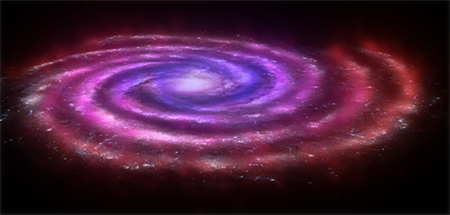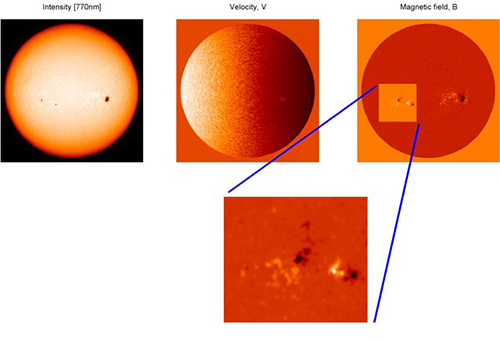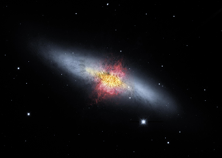
Interstellar and heliospheric physics researchers at JPL study the interstellar medium, the Sun, the heliosphere, and planetary magnetospheres. Their research asks the following key questions:
- How is the solar wind accelerated? How do the magnetospheres of the Earth and other planets couple with the solar wind and the planetary atmospheres?
- How do interstellar clouds give birth to stars and their protostellar disks? Where and how do planets form in the disks?
- How does gas and dust cycling between stars and the interstellar medium govern the structure and evolution of galaxies?
Current Research Tasks
Researchers at JPL are involved in the following tasks:
- Coronal heating, particle acceleration, and the solar wind: The Sun's impacts on the Earth's magnetosphere and ionosphere, and on satellites and power grids; the outer planets' magnetic fields and magnetospheres.
- Evolution of star-forming clouds, protostars, and protostellar disks: Atmospheres of Titan and exoplanets; signatures of planet formation in protostellar disks; constraints on planet formation from primitive asteroids and comets.
- Life-cycles of stars and the interstellar medium, and their roles in galaxy structure and evolution from the Milky Way to high redshift: Molecular clouds and protostellar jets; end stages of stellar evolution; galactic cosmic rays.
Selected Research Topics
Compact Doppler/Magnetograph for Solar Diagnostics

JPL scientists are working on the development of instruments that measure velocity and magnetic fields in the sun’s chromosphere and photosphere, known as Doppler magnetographs. The instrument concept is based on the magneto-optical filter, which can be designed to have very narrow pass-bands in several useful solar absorption lines. The image above shows an example of data from such an instrument – it shows an intensity image on the left, a velocity image in the center and an image of the line-of-sight magnetic field on the right. The cutout below shows details of the highly structured solar magnetic field in the vicinity of two small sunspots. Doppler magnetographs are used for both ground and space-based observations: a group at JPL is developing a flight version of the instrument that will be a factor of 10 lighter than current flight instruments.
Dusty Galaxies and the Interstellar Medium
Researchers are developing new instruments to study the properties of the gas and dust between the stars in galaxies throughout their history. This interstellar material fuels stars and active galactic nuclei (AGN). The primordial hydrogen gas appears to have been enriched with heavy elements as the first, very massive stars formed. The elements carbon, oxygen, nitrogen, and silicon formed dust, which blocks optical and near-IR radiation. Thus for much of galaxies’ history, the birth of stars and AGN from the interstellar gas is hidden to short-wavelength observations. Fortunately, a rich set of spectroscopic tools is available at mid-IR through sub-millimeter wavelengths to probe these regions. Researchers are developing the instruments to perform these spectral measurements, with an emphasis on the best possible sensitivity and wide bandwidth to detect multiple lines and observe galaxies with unknown redshifts.
Work at JPL has focused on a sensitive grating spectrometer for the proposed M-Class ESA-JAXA Space Infrared Telescope for Cosmology and Astrophysics (SPICA) mission. SPICA is a 3.5-meter telescope actively cooled to below 5 degrees kelvin. The very low-background platform is especially compelling for moderate-resolution extragalactic spectroscopy. The proposed instrument for SPICA, called Beamline Instrument Software Support (BLISS), could provide a new capability for survey spectroscopy of the galaxies which produced the cosmic far-IR background and gave rise to our modern universe. The far-IR fine-structure and molecular emission reach us through the dust so can reveal the galaxies' redshifts, AGN content, gas properties and metallicities -- in aggregate, the history of these dusty galaxies. Another opportunity to fly this technology could be as part of the SAFARI spectrometer under consideration for the SPICA mission.
JWST/MIRI
The James Webb Space Telescope (JWST) will soon be the premier astronomical space observatory, following in Hubble's footsteps but working primarily in the red to mid-infrared region (0.6 - 27 microns wavelength). The Mid InfraRed Instrument (MIRI) works in a wavelength range similar to WISE (5 - 27 microns) and will take advantage of JWST's large 6.5-meter mirror. It could study every phase in the history of the Milky Way and other galaxies, from the first galaxies formed after the Big Bang, to those forming stars in the present day.
The High-resolution Airborne Wideband Camera-plus (HAWC+) on SOFIA

HAWC+ is a far-infrared camera and imaging polarimeter. It is designed to allow imaging of polarized and unpolarized light in five broad bands between wavelengths of HAWC+ is a far-infrared camera and imaging polarimeter operating on the airborne SOFIA 2.5 m telescope. It provides imaging of polarized and unpolarized light in five broad bands between wavelengths of 40 μm and 300 μm. HAWC+ observations support many topics, including:
- Estimates of magnetic field strength and turbulent power spectrum in nearby molecular clouds
- Efficiency of dust grain alignment
- Magnetic field configuration of the Galactic Center
- Magnetic structure in the dense interstellar medium of nearby bright galaxies.
HAWC+ is advancing our knowledge of properties of the interstellar dust and interstellar magnetic fields.
ASTHROS
ASTHROS (the Astrophysics Stratospheric Telescope for High Spectral Resolution Observations at Submillimeter-wavelengths) is a 2.5-meter-aperture balloon-borne observatory that will build the first detailed, spectrally-resolved high-spatial-resolution three-dimensional maps of ionized gas in Galactic and extragalactic star-forming regions. ASTHROS will map the gas by observing simultaneously the 122-µm (2.459-THz) and 205-µm (1.461-THz) fine-structure lines of ionized nitrogen.
CuSP/VHM
The CubeSat to study Solar Particles (CuSP) is the first interplanetary space physics mission. CuSP will explore how solar wind particles are accelerated to high energies at shock fronts. This is an important open problem in the study of space weather's dangers for flight hardware and astronauts. Led by the Southwest Research Institute (SwRI), CuSP has three instruments, including JPL's vector helium magnetometer (VHM).
Parker Solar Probe
Parker Solar Probe is NASA's flagship mission to our sun and the first spacecraft to "touch" the sun by diving into its corona, or hot upper atmosphere. Among Parker's four instrument suites is ISIS, the Integrated Science Investigation of the Sun, which includes low- and high-energy particle instruments. The latter, called EPI-Hi, uses stacked layers of detectors, with the front few layers made of ultra-thin silicon segments, enabling particles' directions to be tracked. Charged particles are identified by measuring how deep they travel into the detector stack and how many electrons they pull off atoms in each detector. When closest to the sun, EPI-Hi will record up to 100,000 particles per second.